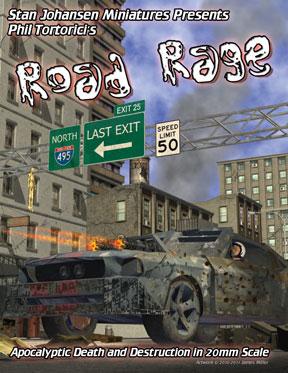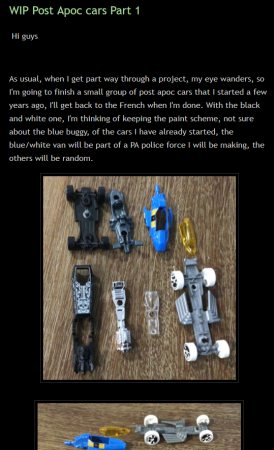
Apocalyptic Death and Destruction in 20mm Scale
Description
The game started as a set of car combat rules for convention play, designed by Robert Groves. The design was then expanded by Phil Tortorici (his name is on the cover) and Nick Tortorici, adding more of a weapons focus while aimed at a four-hour-long game that could fit in a gaming convention time slot.
Team Design
Prior to play, each gamer must have a completed Team Record Sheet. One of the seven pre-designed teams can be used, or the player can design his own team.
Each car has a Driver and a Sidekick; for competition games, their skill levels will usually be set by the umpire for fairness; for a friendly game, skill levels can be determined by dieroll.
Car design is simplified by assuming that vehicle armor, top speed, acceleration, and weapons capacity are all linked together. In other words, a more heavily armored car will also be slower and can carry more weapons; a lightly armored car will be faster but carry fewer weapons.
Weapons are rated in terms of the space they take up, in LMGEs (Light Machinegun Equivalents). Each team member may have one weapon and one defense. For example, a car with average armor can carry 6 LMGEs of weapons. Giving the driver a .50 cal MG as his offensive weapon would take up 3 of the 6 spaces.
Weapons include guns, grenade launchers, flamers, rockets, and missile launchers, mounted in turrets, swivel mounts, pintle mounts, or fixed mounts. Defensive packages include oil sprayers, smoke emitters, flaming oil, and block or grenade droppers (rear-firing guns can also be used as defenses).
Before each game, the Prison Warden (umpire) deals three random Upgrade cards to each team. These provide special equipment, skill bonuses, or other benefits.
The Course
It is the role of the Prison Warden (umpire) to design the racing course and determine the victory conditions (completing a certain number of laps or last-man-standing).
At the start of the race, all cars' weapons and defenses are deactivated.
As in the movie, certain 'pads' are placed along the racing course. When the lead car completes a lap, a random pad is activated. There are three types of pad: Swords (activates weapons), Shields (activates defenses), and Skull (activates an obstacle in the course). When a car crosses an activated pad, a dieroll is made to see if the pad does its thing.
If a player has fallen behind, the Warden may activate a shortcut to allow that car to catch up in the race.
Game Play
The game is played in a series of rounds, each representing five seconds of time. Each round is broken into five impulses.
During each impulse, players take actions in race order – that is, the player furthest ahead moves first, while the player furthest behind moves last. A vehicle's current speed determines how many 'car lengths' it moves per impulse. (A 'car length' is three inches.)

If a car wishes to accelerate, that is announced at the start of the impulse, and the car's speed is adjusted. (Based on armor level, each car has a maximum acceleration per impulse and per round, as well as a maximum possible speed.)
If a car wishes to decelerate (representing the driver taking his foot off the gas), he announces this at the start of the impulse, and speed is reduced by 10mph.

If the player wants his car to do anything besides driving straight ahead, he'll need to try an action. Braking is a faster way to slow a car. There are also several Maneuvers: Swerve, Drift, Veer, and Turn. To succeed at an action, the player must make a Task Check, comparing character skill level versus task difficulty level to get a target number, and rolling a d10. If the Task Check is unsuccessful, the margin of failure determines the Loss of Control: Fishtail, Skid, Hard Skid, Spin Out, or Rollover. Task Checks are also required when vehicles encounter hazards on the track, such as crates, potholes, oil, water…
Rules also cover the consequences of collision with other objects and vehicles.
Combat
Each character can fire each of their weapons and defensive systems once per round. Firing occurs at the end of the impulse. The weapon's Rate of Fire determines how many attacks can be made at one time, after which one 'shot' is marked off its ammo. A Task Check determines if a hit is scored, followed by a Penetration roll (comparing weapon penetration to target's armor).
Each vehicle's record sheet includes a damage track. As vehicles accumulate damage, they progress from Undamaged to Damaged to Wrecked (with consequences to performance) to Totaled (out of the race). The damage track also indicates when Critical Hit checks must be made; these come more often as a vehicle becomes more damaged. There are 50 possible critical hit results, from "scary, not a real problem" to "ammunition cook-off."
Optional Rules
The optional rules either add more complexity to the game, or are considered unbalancing in the 'prison race' scenario. Rules cover additional weapons and defensive systems, specialty ammo, repairs and jams and reloading, additional maneuvers, and special cards (Set Backs and Events).
Editions
Current version is 1.2.Supplements

Road Rage: Buzzard Bikers of the Back Streets adds rules for motorcycles and pedestrians to the game system.

Optional laser-cut plastic templates, to replace the ones in the rulebook.







